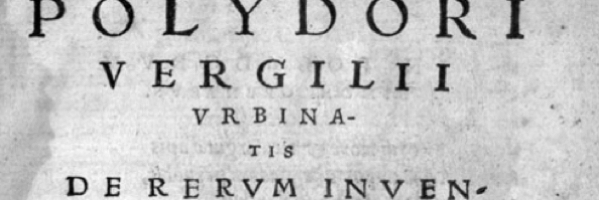Polydore Vergil, 1499 (Les Bibliothèques Virtuelle Humanistes, 1546)

When back in Montpellier in September 1664, Lister recorded reading: ‘Polyd. Virgilis. Urb. de Rer. inventiorib’.
Polydore Vergil of Urbino (1470-1555) was a humanist scholar who lived in England from 1502 to 1553 where he served as deputy papal collector until 1514 and from 1508 as archdeacon of Wells. His enormously popular De Rerum Inventoribus was a history of invention and origins of human activity, part of the humanist enterprise to trace ideas to their origins (ad fontes). 1
Book I investigated the creation of the world, the origin of religion, the divine origins of marriage and culture, and the concept of the gods and the word ‘God’. Vergil then turned to human inventions in the post-lapsarian era, including the origins of the alphabet and the seven liberal arts. Books II and III analyzed the practical and the mechanical arts, such as the origins of agriculture, architecture, towns, commerce, and tools. There were innumerable editions of this work 2.
As the research of Vera Keller has demonstrated, invention, whether ancient, modern, or not-yet-discovered, was a major preoccupation of early modern thinkers such as Vergil and Francis Bacon. Bacon, in particular, formulated the idea of the desiderata list, or inventions that were seen as particularly desirable. These lists served as ‘markers for what humankind might achieve together . . . serving to epxand the horizon of possibility’. 3 Bacon and his contemporaries
compared lists not only of ancient and modern inventions, but of future ones – longed-for objects often drawn from the category of the lost things. The practice of comparing time periods as lists of objects suggested that invention was contingent upon history rather than pre-determined by reason. Many of the most impossible seeming objects (flexible glass, the perpetual motion, the philosopher’s stone, etc.) had been found before, and thus should be able to be invented again. While suggesting a widened horizon of possibility, the list of lost things also pointed to the fact that invention was not stable; objects might be discovered at a point in time, only to fall later into a “catalogue of lost things” conceptualized as a threatening and ever present space. It was the job of the historian, by listing and writing about inventions, to keep them from falling forever into the abyss”. 4.
A short, animated version of Professor Keller’s research can be seen below
- See Denys Hay, Polydore Vergil: Renaissance historian and man of letters (Oxford: Clarendon Press, 1952); Catherine Atkinson, Inventing Inventors in Renaissance Europe: Polydore Vergil’s De Inventoribus Rerum (Tübingen: Mohr Siebeck, 2007). ↩
- See John Ferguson, John F. Fulton, and Charlotte H. Peters, Hand list of editions of Polydore Vergil’s De inventoribus rerum (New Haven: Yale Medical Library, 1944). ↩
- Vera Keller, “The ‘New World of Sciences’: The Temporality of the Research Agenda and the Unending Ambitions of Science”, Isis 103 (2012), 727-734, on p. 727 and p. 730. ↩
- Vera Keller, ‘Accounting For Invention: Book-Keeping and the History of the Wish List’, Material Cultures 2010, University of Edinburgh Centre for the History of the Book ↩
